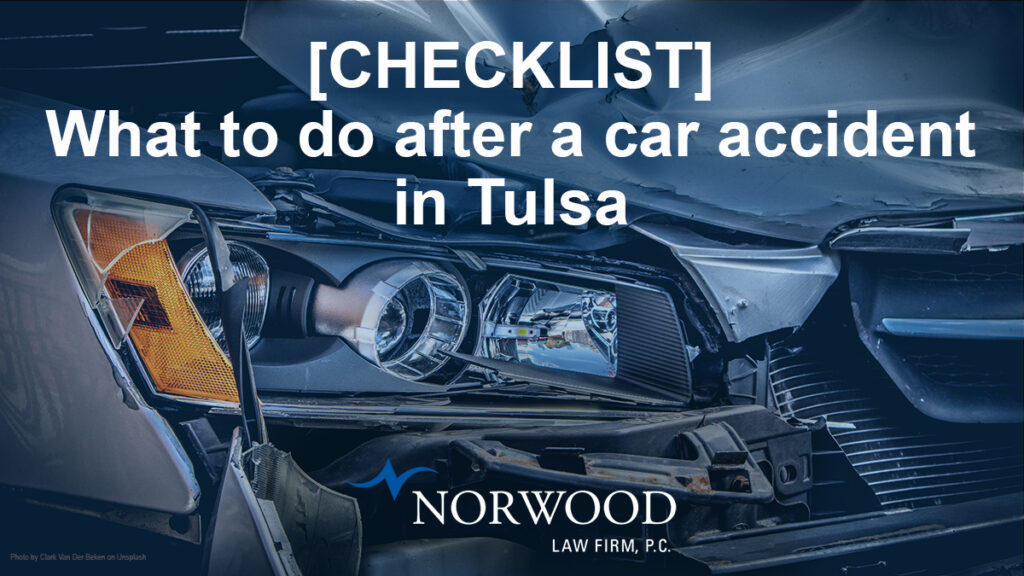By Attorney, Joe Norwood
No matter how minor the damage, car crashes are always scary. They are also notoriously common. Even more shocking is how common it is for a car accident to result in serious property damage or injury. Check the current car crash data in Tulsa County or your area of Oklahoma for the most up-to-date car crash information.
- At the Scene of a Car Crash: What You Should Do
- After the Crash: Steps to Follow After Leaving the Scene of a Car Crash
- What if New Injuries Arise or Someone Dies from Accident-Related Complications After the Accident?
- How Long After a Car Crash Can I Make a Personal Injury or Wrongful Death Claim?
If you have never been involved in a car accident, chances are you will be at some point in your life. The car insurance industry estimates that the average driver will be involved in a collision about once every 18 years. That means most drivers will be involved in at least three accidents throughout their life.
Joe Norwood and the team at Norwood Law Firm in Tulsa, Oklahoma, understand it’s normal to feel disoriented and shocked after a car accident, especially if it is the first time it’s happened to you. That’s why they’ve created this helpful guide to help you be prepared for a potential car wreck and know what to do after a collision. By following this guide, you will be prepared to respond confidently in a car accident, stay safe, and protect your interests.
At the Scene of a Car Crash: What You Should Do
When you are involved in a car wreck, emotions, adrenaline, and shock make it easy to forget everything you’ve ever learned about what to do after an accident. This checklist will help you remember the steps to take to protect yourself, any passengers, and your interests in the event of a crash. Consider printing this checklist out and keeping it in your vehicle so you can easily access it if necessary. If you have any questions about this checklist or would like more information about your options after a crash, a car accident attorney from Norwood Law Firm can help. Get the printable checklist now.
First, stop at the scene
If you are able, move your car to the side of the road out of the way of traffic. Oklahoma state law requires you to stay at the scene; if you leave before following the next steps, you could be charged with a hit-and-run and face misdemeanor or felony penalties. More details on this are further down in the article.
Check to see if you, your passengers, or other drivers are injured
If anyone is injured, call 911 for emergency help and wait for an ambulance and police to arrive. You are required to call the police if there are any injuries or deaths in the crash.
If you are able, provide assistance to anyone injured or ask a bystander for help
If no one was injured and only property damage occurred, you are not required to call the police. However, reporting an accident is a good idea. The police can provide an impartial record of the scene.
Turn on your car’s hazard lights and turn the engine off, removing the keys from the car
Set up any cones or warning triangles. Limit any discussion of the events of the accident. Do not admit fault. Discuss the accident only with the police, your insurance agent, and your car wreck attorney.
Take pictures and/or videos of the aftermath of the accident
Photograph:
-
- Injuries
- Damage to your vehicle and to any other vehicles involved
- Other property damage
- Road conditions
- The positioning of the cars before being moved (if possible)
- Details about where the accident happened (for example, street signs, and traffic signals)
Gather information about everyone involved in the accident
Get the other driver’s:
-
- Name
- Address
- Contact phone number
- Driver’s license number
- Insurance company name and policy number
- Vehicle description (make, model, and year)
- Vehicle Registration Number
- License plate number
Talk to any witnesses and take note of their names and contact information.
Document the accident. Take note of details to preserve evidence and use it as a reference for filing an accident report.
-
- What time was it when the accident happened?
- What was the weather? How were road conditions? Was visibility good or poor?
- Where did it happen? What road were you on, and what is the nearest cross street?
- What direction were you traveling? What direction was the other car traveling?
- Were there any injuries? Who was injured? What were the injuries?
- Were the vehicles damaged? What damage did they have? Was any other property damaged?
- Were any of the drivers ticketed by the police?
If the police were on the scene, make note of the police report number they will use for this accident. You will need this number when you call your insurance company.
If your car is not driveable
Remove any personal belongings and call a tow truck to move your car.
If you are injured
Take the ambulance to the nearest hospital for medical attention. If you don’t have any injuries, call a rideshare service, family member or friend to get home.
After the Crash: Steps to Follow After Leaving the Scene of a Car Crash
Unfortunately, getting home from the scene of a car wreck does not mean your work is done. In order to protect your rights and begin the insurance claim process, there are a few more steps to take after a crash happens.
- Contact your insurance company to report the accident as soon as possible.
- Contact Joe Norwood, an experienced Tulsa car accident personal injury attorney, to make sure your rights are defended and to ensure you get the most from your insurance claim.
- Keep detailed records of your medical treatment and the progress of any injuries.
- Draft an accident report for your records.
What happens if you leave the scene of an accident in Oklahoma?
Leaving the scene of an accident is considered a serious crime in Oklahoma. If you are involved in a car accident, it is your legal obligation to stop, provide assistance to anyone who is injured, and exchange information with the other driver. If you fail to take these steps and then leave the scene, you can be charged with a hit-and-run.
The penalties for a hit-and-run accident in Oklahoma vary depending on the severity of the accident and the extent of the damage caused. In cases where there is only property damage, leaving the scene of an accident is considered a misdemeanor offense, and you may face a fine of up to $500, imprisonment for up to one year, or both.
In more severe cases, where there are injuries or fatalities involved, leaving the scene of an accident is considered a felony offense. You may face up to 10 years in prison and a fine of up to $10,000. Additionally, your driver’s license may be suspended or revoked.
Overall, it is crucial to remember that leaving the scene of an accident is a serious offense in Oklahoma and can have significant consequences. If you are involved in a car accident, it is essential to remain at the scene, provide assistance, and exchange information with the other driver to avoid legal trouble.
What if New Injuries Arise or Someone Dies from Accident-Related Complications After the Accident?
The adrenaline and physical trauma response individuals experience in a car wreck can easily mask symptoms of injury or block pain for a time. Because of this, it is not uncommon to see injuries manifest symptoms days or even weeks after an accident.
Soft-tissue injuries like whiplash are common traumas that sometimes take days to show symptoms. Soft-tissue injuries like whiplash do not appear on x-rays like fractures and other injuries, so it can be difficult to diagnose at the scene. Concussions, neck and back pain, headaches, and PTSD may also have delayed symptoms of pain. If you experience any symptoms of whiplash, concussions, or other pain after an accident, seek prompt medical care.
How Long After a Car Crash Can I Make a Personal Injury or Wrongful Death Claim?
Even if your pain and injuries surface days or weeks after the accident, you have time to seek compensation if you were not at fault in the accident. The statute of limitations for personal injury in Oklahoma is two years from the date of the vehicle crash. If you experience accident-related pain within two years of your car accident, a personal injury lawyer can help you get the recompense you deserve and protect your rights.
If someone involved in a car accident is injured and later dies due to complications from the crash, a family member can bring a wrongful death claim. The statute of limitations for wrongful death is more forgiving than for personal injury. It runs out two years after the date of death, rather than the date of the accident, giving the family time to seek recompense after losing a loved one.
Whatever your injuries or experience, a compassionate car wreck attorney can protect your rights and help ensure you get the compensation and closure you need after an accident.
How an Experienced Attorney Can Help You After a Car Accident
Navigating insurance claims, injuries, and bills after a car accident can be challenging and anxiety-inducing. Insurance companies often work to give you the lowest compensation possible for both property damage and injuries. Tulsa attorney Joe Norwood is an expert in challenging insurance companies and defending your rights. If your insurance adjuster won’t settle your claim, or if there is an auto collision insurance claim dispute, the team at Norwood Law Firm can help.
As a local Tulsa car accident attorney, Joe Norwood and his team will work to protect your financial interests and your legal rights after an accident. Contact Norwood Law Firm today for a consultation.

